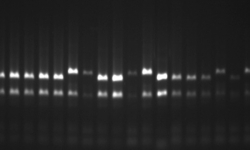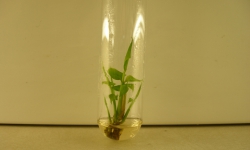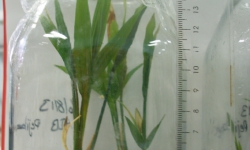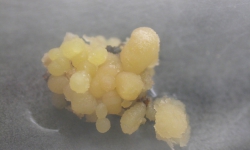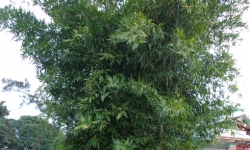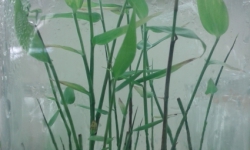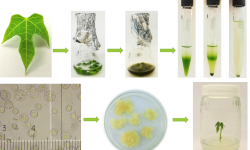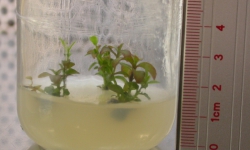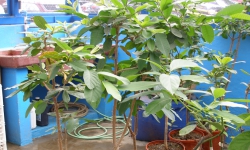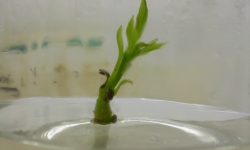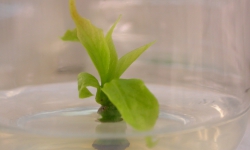Current research projects:
Use of biotechnology for the characterization of genotypes and physiological processes in pitahaya
Pitahayas (Hylocereus spp.) are perennial climbing cactus plants native to tropical areas of North, Central and South America. Their fruit-pulp color ranges from white (in H. undatus) to red and purple (in H. polyrhizus and H. costaricensis). In Costa Rica there are wild and cultivated red and purple-fleshed pitahayas, which have gained importance over the last years for fresh fruit consumption and also, in food processing, as a source of natural pigments due to their high contents of betalains.
The aim of this research project is to use molecular and morphological markers to generate information on Costa Rican pitahaya species and genotypes and to characterize the flowering process at the field level using molecular methods in order to support future breeding programs. Another purpose is to generate methodologies for the in vitro production of betalains.
Uses of biotechnology for clonal propagation of papaya hermaphrodite plants and characterization of the fruit maturation process
Papaya is native to Mexico, Central and Northern-South America. Papaya plants may have male, female or hermaphrodite flowers. Plants with hermaphrodite fruits are preferred in the market. Propagation is usually conducted using seeds but this renders mixed populations, with female or hermaphrodite plants in the case of the “Pococí hybrid”. Since 2006, this project has attempted to define protocols for mass propagation of the papaya hybrid “Pococí” through somatic embryogenesis to ensure propagation of hermaphrodite plants. Moreover, in order to understand the process of papaya “Pococí” fruit ripening, some candidate genes (poligalacturonase, endoxilanase, pectinesterase, expansin and ACC deaminase) associated with the process were investigated using gene expression analysis.
Characterization of plant nutrient absorption in in vitro-cultured plants
Nutrient absorption by plants under in vitro culture has not been studied in much detail until now. The most widely used culture medium is the MS (Murashige and Skoog 1962) and some others like the Woody Plant Medium (WPM). However, commonly observed problems in plants (hyperhydricity, necrosis, bud overdevelopment, etc.) maintained in in vitro culture often have a nutritional base. The cost of the nutrients and the need for in vitro plant growth optimization make it necessary to provide the best conditions to ensure high-quality in vitro plants.
This project focuses on the analysis of the absorption of nutrients in three plant species maintained under in vitro culture (tobacco, bamboo and pitahaya) for improvement of plant growth and development.
Evaluation of alternative strategies for clonal propagation of peach palm (Bactris gasipaes Kunth)
Peach palm (Bactris gasipaes Kunth) is native to tropical America and is commercially cultivated in the humid tropics, mainly in Brazil, Peru, Colombia and Costa Rica. Both the fruits and the heart of the palm are of commercial interest. In Costa Rica there are peach palm germplasm banks that hold large genetic diversity. Peach palm plants in these gene banks can be used for breeding and conservation of a valuable genetic resource that is in a rapid process of erosion. The aging and even death of several plants in the germplasm banks is a problem with serious consequences. Since 2007 this project has worked in tissue culture as a way for clonally propagate this plant species and focuses on establishing a system for efficient clonal multiplication of peach palm plants from germplasm banks in Costa Rica.
Micropropagation of native species of Guadua (Poaceae: Bambusoideae) in Costa Rica
Bamboos are woody and herbaceous monocot plants with high diversity in stem size, thickness and shape. This has allowed their use in diverse human activities. Some species can reach up to 30 m in height and 21 cm of stem diameter. In Costa Rica the following Guadua species can be found: G. angustifolia, G. angustifolia var. bicolor, G. amplexifolia, G. paniculata and G. macclurei; the latter endemic of Costa Rica and Nicaragua. Bamboo conventional propagation is conducted by seed and culm or rhizome sections. However, these methods have several disadvantages: first, bamboo flowering is generally unpredictable and spaced in time, on the other hand, the use of very large propagules increases costs and also the reproduction rate is very low. This is why micropropagation can be an attractive alternative for efficient multiplication in this plant group. The use of microcuttings might allow a very high multiplication rate and could solve the lack of material for large-scale production.
Isolation, culture, fusion and regeneration of protoplasts in ornamental species of the Solanaceae family
A plant cell without the cell wall is called a protoplast. Protoplasts have great potential for genetic improvement through the use of techniques, such as somatic hybridization, direct gene transfer and microinjection of DNA, Agrobacterium-mediated transformation and even for the induction of mutations. They can also be a source of somaclonal variation. The purpose of this project is to use somatic hybridization to improve some characteristic in ornamental plants belonging to the Solanaceae that have commercial interest. For example, the inclusion of resistance to several pathogens in Nicotiana sanderae, found in the species N. gossei and N. debneyi, and also to improve morphological characteristics in Petunia hybrida.
Establishment, multiplication and in vitro regeneration of guava (Psidium guajava L.)
Guava belongs to the family Myrtaceae. It is native to the American tropics, but is widely cultivated in the tropics and subtropics around the world. Its fruits are used both for fresh consumption and for the production of various processed products. Propagation is usually conducted by seeds, although this results in high genetic variability of the progeny. In this context, in vitro culture techniques allow increasing the rates of clonal propagation and increases the chances of obtaining pathogen-free plants. The objective of this project is the establishment of a protocol for in vitro multiplication and regeneration of guava plants from buds obtained from adult plants.
Micropropagation of avocado (Persea americana Mill) rootstocks used in Costa Rica
Avocado (Persea americana Mill) is a perennial species belonging to the family Lauraceae which can be found from Mexico to Colombia. In Costa Rica avocado cultivation has becoming the second most important agricultural activity in the East-Central area after coffee.
In order to increase homogeneity in the harvest and decrease the length of the juvenile phase, avocado varieties are propagated by grafting scions on rootstocks, which are commonly propagated by seeds (seedling rootstocks). Clonal propagation of rootstocksis difficult and in this context, in vitro culture is an alternative for their rapid clonal propagation (micropropagation).
The purpose of this investigation is to generate a protocol for in vitro micropropagation of avocado rootstocksthat have good agricultural characteristics, such as tolerance to Phytophthora cinnamomi, dwarfing effect and good fruit production.
Development of food security in Latin America through academic excellence via international cooperation
Aiming at reducing extreme poverty and other factors that hinder equitable social and economic development in many Third World countries, in 2000, the United Nations adopted the Millennium Declaration. Eight key targets known as the Millennium Development Goals were identified to meet the basic needs of the poorest. By defining these goals, priority was given to "eradicate extreme poverty and hunger". Due to the magnitude and urgency of the problem and the existence of competencies in the fields of agricultural, natural and socio- economic sciences at the University Hohenheim, Stuttgart, Germany, together with the extensive network of cooperation that this university has with various institutions with similar competences in the world, the Food Security Center (FSC) was created in order to find solutions to eradicate extreme poverty and hunger. Through collaboration with the FSC, the objectives of this project at the University of Costa Rica are developing knowledge, strengthen research capabilities and education among universities through international networks and promote the development of food security and sustainable agriculture in Latin America. The University of Costa Rica is the coordination institution of all FSC activities in Latin America. Among its activities, the project organizes and funds short- and long-term courses, as well as research stays at the University of Hohenheim and at higher education and research institutions in other developing countries in Latin America, Africa and Asia.
For additional information about the Food Security Center:
 |
 |





